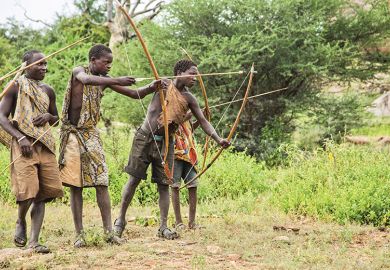Creation myth, astrological treatise, tribal charter, land document - the Popol Vuh not only fills all of these roles, but is unquestionably the greatest piece of literature ever produced by the native peoples of the New World. Known to scholars since its discovery in Guatemala in the middle of the last century, it has been translated many times into many languages, including French, German, Spanish, Russian, and English; and it has even been simplified into children's books, since the story it tells is sufficiently vivid to appeal to all ages of readers. But of all of these versions, the best in any language is that by the American anthropologist Dennis Tedlock, first published to great acclaim in 1985 and now appearing in a revised edition.
Although the original manuscript of the Popol Vuh, one of the treasures of Chicago's Newberry Library, is written in Quiche, the language of the most powerful state in the Maya highlands on the eve of the Spanish conquest, it uses the Latin alphabet introduced by the Spanish conquerors. Tedlock presents compelling evidence that the MS is a transcription from a lost hieroglyphic original, as the authors of the Popol Vuh hint with their final statement, "There is the original book and ancient writing owned by the lords, now lost . . .". What makes Tedlock's translation so authentic and convincing is that he is himself an instructed Maya day-keeper, or calendar-priest; he has checked every part of the Maya-Quiche original with Andres Xiloj, his teacher and an outstanding religious practitioner in the Quiche community of Momostenango. Much of the language is richly symbolic and esoteric - while it was clear to the noble audience for whom it was intended, it is not necessarily transparent to ourselves, but Tedlock's introduction and abundant footnotes provide answers to most of the puzzles posed by the text.
The Popol Vuh opens grandly with the gods' creation of the universe from primordial chaos, and follows with the appearance of dry land, and plants and animals. Yet the gods are hungry for words of praise from human mouths, but their initial attempts to create humans end in disaster. Here, the narrators of the book have condensed a far more extensive genesis myth, which, by comparison with the Aztec creation story, should have involved multiple creations and destructions of previous worlds (the closely related Cakchiquel Maya say we are in the fourth of these worlds).
For the average reader - and for the archaeologist - the most exciting part of the book is a Hero Twins mythic cycle, which must take place at the end of the last creation before the present one. This narrative is told in a complex series of flashbacks, in which the Twins, as boys and as handsome young men, fulfil their primary task, that is, to rid the universe of monsters so that true humans can be born in a more orderly world. The Twins are trickster heroes, and it is through trickery that they destroy a monstrous bird which lays false claim to being the sun itself; they then descend to Xibalba, "Place of Fright", the Maya Underworld, where they defeat - again through trickery and legerdemain - the gods of death and disease, and rise triumphantly to the heavens as the sun and the moon.
Tedlock is fully aware that recent scholarship has shown that many details of this cycle were well known to classic Maya painters and scribes, and appear throughout Maya religious iconography (especially on pictorial ceramics). As a consequence, he has been able to illustrate the Hero Twins cycle in the present edition by using these ancient images.
Thus far, the story line of the Popol Vuh is embedded in what we would call myth, and quite probably the next episode in it - the creation of the first four true men and their wives - would fit in this category. But now the book moves seamlessly into what looks like "real" history, with the origin of the tribes in a city called Tulan, and their migration to highland Guatemala, where they were at the time of the Spanish conquest. Yet the distinction which the ancient Greeks made between myth and history was not an issue to the native Maya narrators of the Popol Vuh, and Tedlock prefers to use the ersatz term "mythistory" instead.
For us, the Popol Vuh in Tedlock's fluent translation can be read on many levels. On the "lowest", it is a wonderfully gripping yarn, particularly the doings of the Hero Twins (small wonder that a successful animated film has been made of the latter). On a "higher" level it is inspiring literature, on a par with the book of Genesis itself, with rich use of narrative and poetic devices (well described by Tedlock) to hold the listener's and reader's attention. To the ancient Maya ruling elite, it was both a religious and political document, the Hero Twins cycle providing the spiritual charter for these rulers, and the migration legend establishing the right of the most powerful Quiche lineages to land and tribute. To the Maya intelligentsia, it was an esoteric, astronomical treatise, linking the gods and mankind to the realm of the stars and planets (a subject on which Tedlock is a leading authority).
To anyone with a curiosity about indigenous Maya systems of thought, this new edition of a Quiche classic is a must.
Michael D. Coe is curator of anthropology, Peabody Museum, Yale University.
Popol Vuh: The Mayan Book of the Dawn of Life
ISBN - 0 684 81845 0
Publisher - Simon & Schuster
Price - £9.99
Pages - 388
Translator - Dennis Tedlock
Register to continue
Why register?
- Registration is free and only takes a moment
- Once registered, you can read 3 articles a month
- Sign up for our newsletter
Subscribe
Or subscribe for unlimited access to:
- Unlimited access to news, views, insights & reviews
- Digital editions
- Digital access to THE’s university and college rankings analysis
Already registered or a current subscriber?



